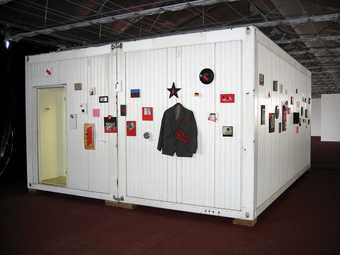
Fig.1
Installation view of Mladen Stilinović’s Exploitation of the Dead 1984–90 at Documenta 12, Kassel, 2007
© Mladen Stilinović
Courtesy Branka Stipančić
Documenta 12 in 2007 included a presentation of Mladen Stilinović’s installation Exploitation of the Dead (Eksploatacija mrtvih) created between 1984 and 1990. Exhibited in the Aue-Pavilion, a selection of the small, wall-mounted objects that make up the work were hung on the exterior and interior walls of a white corrugated metal trailer (fig.1). Exploitation of the Dead consists of a group of approximately 500 objects, from which a selection is chosen for any given installation of the work.1 The items are materially diverse, combining collage and painting with found objects, united visually through an overall colour scheme of red, pink, black, and some white. The work’s art historical references include the suprematism of Kazimir Malevich (1879–1935), Russian constructivism, social realism, the early twentieth-century avant-garde movement of Zenitism from Zagreb and Belgrade, and Croatian abstract painting of the 1950s. Stilinović, who was born in Belgrade in 1947, created Exploitation of the Dead in Zagreb during the political and economic twilight of the former Yugoslavia. Edvard Kardelj, the key economic engineer of Yugoslav self-management socialism, died in 1979, followed by the country’s founding leader Josip Broz Tito in 1980, creating a vacuum in leadership that was compounded by the debt crisis of 1982.2 The period from 1979 onward saw hyperinflation along with skyrocketing unemployment and national debt, escalating a crisis that culminated in the bloody breakup of the country over the course of the 1990s.
Documenta attracts an audience which is geographically mobile, highly educated, and internationally diverse. As such, the presentation of Exploitation of the Dead there addressed that audience, while also subtly reenacting an early exhibition of the work that took place in Zagreb in 1989 for a much more limited public. This reenactment was noticeable in the choice to install the works on and in a metal trailer. For the 1989 showing, one of the early public presentations of the work, Stilinović installed the objects on the outside walls of a similarly sized worker’s canteen in Zagreb, for a special one-day project and the creation of a film.3 Stilinović described the exhibition at the canteen as neither an attempt to appropriate the space nor to bring the workers closer to art, but rather as an alternative to the pretense of neutrality offered by a gallery and its predictable framing of art.4 He also described the installation as a ‘brutal’ confrontation of the living, ‘intact and almost holy’ canteen with the dead signs that make up the work (on which more below). Stilinović specifies that the work ‘changes the canteen into a gallery, and that false temporary travesty interests me, and I’m aware of its falsity’.5 Art historians Ivana Bago and Antonia Majača have argued that siting the work in the canteen is painful for them to witness insofar as it addresses the worker, the key ideological figure in the communist future projected by the Yugoslav state, the death of which Exploitation diagnoses.6 Stilinović’s comment about his interest in the canteen’s ‘false’ transformation into a gallery suggests an attraction to the idea of viewers’ bodies circulating in the same space as would workers’ bodies at another moment, but conducting different kinds of activity there. Importantly, the point of installing the work in the canteen is not to make workers into art viewers, but rather to highlight the breach between manual labour and the ‘work’ of making and viewing art.
This article analyses the relationship that Exploitation of the Dead sets up between the bodies of the people it addresses, and the bodies of the people it represents. Although the work was originally created in Zagreb and shown there for a very local audience, and then subsequently over the ensuing decades circulated to venues including Documenta with international audiences who have little knowledge of the culture and politics of Yugoslavia, the way in which it addresses viewers across these contexts is a difference of degree and not of kind. Even when he was creating art for a tiny local audience in Zagreb, Stilinović was aware that his practice might ultimately find a much broader audience.7 Exploitation of the Dead interpolates all its viewers as implicated at an intimate physical level with the history it shows, but also as people in a privileged position whose acts of viewing constitute an exploitation of real bodies. Branislav Jakovljević’s recent scholarship has demonstrated the close connection in late twentieth-century Yugoslavia between experimental art practice and the socialist politics of labour.8 I argue that from the pessimistic 1980s, Exploitation of the Dead looks back to remember the history of avant-garde art as it unfolded in and around Yugoslavia as a story which necessarily concerns both the presence of viewers’ bodies, and of labouring bodies coordinated by socialist ideologies of labour. The work addresses viewers’ bodies across its various exhibition contexts while also emphasising how the writing of history is a process of exploitation – a very visceral one, where we forcibly recruit other people’s life stories and the accumulated products of their labour into our own ideologically motivated projects. As such, Exploitation of the Dead is rich with historical references but solicits even viewers not conversant with that history, as it frames every reading as in some sense a motivated misreading.
Stilinović’s art is rigorously conceptual. These conceptual roots have logically resulted in a tendency among art historians and critics to emphasise concept and downplay materiality in the interpretation of his work.9 But here the focus is on viewership, and the materiality of Exploitation of the Dead is in fact extremely important to the relationships that the work sets up with viewers. Moreover, the cycle’s engagement with twentieth-century histories of the avant-garde object, specifically of Russian constructivist objects, is an important component of the work’s critical treatment of the relationship between artwork and labour.
Many deaths
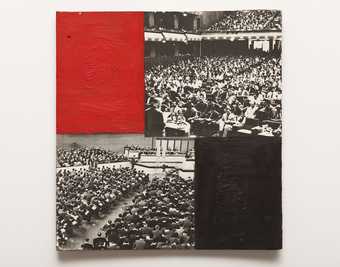
Fig.2
Detail from Exploitation of the Dead 1984–90
© Mladen Stilinović
Courtesy Branka Stipančić
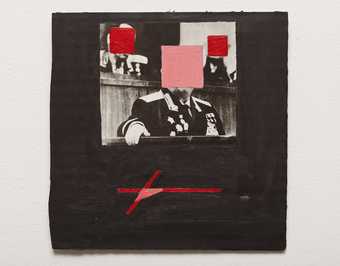
Fig.3
Detail from Exploitation of the Dead 1984–90
© Mladen Stilinović
Courtesy Branka Stipančić
It is important to give a full sense of the work before continuing. As stated above, Exploitation of the Dead comprises around 400 objects. Many are roughly hand-sized wooden panels in various shapes, painted in a geometrical style, in a red, pink, white, and black colour scheme. The individual works are characterised by a mix of degrees of three-dimensionality: some are flat and others consist of assemblages of objects, such as a fork stuck through a stack of now-worthless Yugoslav dinar notes, money being a recurring motif among the pieces. Other found objects, including alarm clocks, are placed on small, somewhat roughly-cut wall-mounted wooden shelves. Still other objects, such as a suit jacket (a symbol of bureaucracy) painted with red shapes, hang directly on the wall, and what might be referred to as ‘picture-panels’ – small pieces of wood bearing archival photographs – are often superimposed with painted abstract shapes. These photographs include images of Malevich and his coffin, as well as images of collective labour, group exercise, and people participating in socialist assemblies (fig.2). One panel holds a photograph of three men in high-ranking Yugoslav military uniform rendered anonymous by uneven, impasto red and pink squares painted over their faces (fig.3). Other wooden panels bear objects fixed directly to them, such as a severed white bird’s wing (to be discussed further below), or a few handfuls of coins held in shallow, glass-fronted boxes (fig.4). One version of this glass-fronted coin box is vertically elongated in shape and contains a soup ladle with its bowl partially buried in the coins, ready to scoop up an individual serving (fig.5).

Fig.4
Detail from Exploitation of the Dead 1984–90
© Mladen Stilinović
Courtesy Branka Stipančić

Fig.5
Detail from Exploitation of the Dead 1984–90
© Mladen Stilinović
Courtesy Branka Stipančić
The colour palate and geometric shapes that predominate throughout the cycle evoke the suprematism of Kazimir Malevich, a central figure in Stilinović’s work, who is additionally present through the images of his corpse and coffin. Stilinović has also cited EXAT 51, the Croatian geometric abstract painting movement of the 1950s, as a reference.10 Constructivism is another visual touchstone, not only through the forms and colours that resonate with its graphic design, but also through the presence of the everyday objects including plates and spoons, some painted with geometric shapes, which read as somewhat pathetic evocations of avant-garde-designed functional objects. Art historian Branka Stipančić, in a 1988 text on the work, describes it as populated by ‘shells of the Russian avant-garde’.11 A number of other panels feature representational painting in a somewhat clunky, comedic style. One such panel bears three red crosses – evocative of Malevich as well as of Christianity – positioned on the diagonal. The bottom cross is being sniffed by a small pink piglet, a cute, diminutive rendition of the classic symbol of capitalist greed (fig.6). Throughout the group of objects, crosses and stars abound. The group of works is also replete with photographic images, which Stilinović said refer to the ‘everyday social realism’ of the media and official life under socialism.12 When installed, the cycle often also includes fresh cakes and pastries perched on miniature shelves, left to age over the course of an exhibition (fig.7). The intense heterogeneity of the collection is essential to the experience of the work. Viewing it feels like a trajectory of accumulation, like moving from one entry, to another, to another in a bottomless archive, where our sense of the whole can shift substantially as we go from one thing to the next.
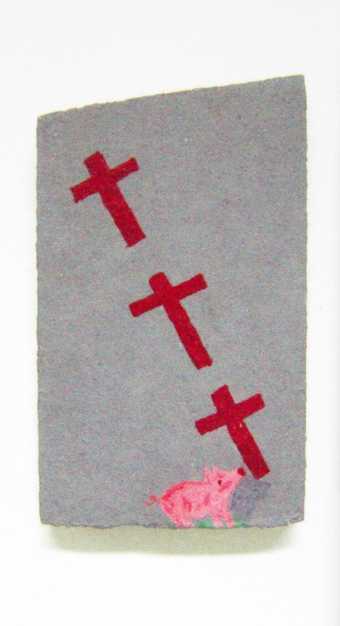
Fig.6
Detail from Exploitation of the Dead 1984–90
© Mladen Stilinović
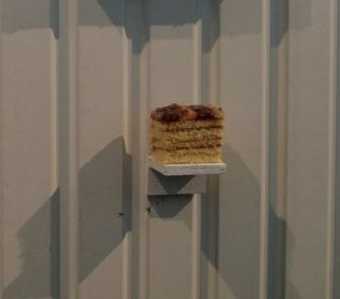
Fig.7
Detail from Exploitation of the Dead 1984–90
© Mladen Stilinović
Stilinović belonged to the generation that curator Marijan Susovski dubbed the New Artistic Practice (Nova umjetnička praksa), a cohort of young Yugoslav artists working from the late 1960s through the 1970s in multimedia, conceptually oriented practices that engaged with public life from a critical leftist perspective.13 Artists associated with the New Artistic Practice were explicitly interested in the twentieth-century heritage of the avant-garde. An important vehicle for the transmission of that history was Camilla Gray’s book The Russian Experiment in Art 1863–1922 (1971), which was translated into Serbian and published in Belgrade in 1978.14 Stilinović curated an exhibition entitled According to the Russian Avant-Garde (Prema ruskoj avangardi) in Zagreb in 1984, the same year he began making Exploitation of the Dead.15 This show, which included works by local artists such as Julije Knifer and Dimitrije Bašičević-Mangelos, examined how they ‘variously interpret (appropriate? manipulate?) the Russian avant-garde’.16 In that decade, other important acts of engagement with avant-garde history include Stilinović’s friend Vlado Martek’s signs entreating viewers to ‘Read Malevich’, Rimbaud, and a series of other avant-garde writers (the series began in 1978 and is ongoing); Belgrade artist Goran Djordjević’s series K.M. Copies 1980, a group of deliberately amateurish copies of Malevich’s paintings; The Last Futurist Exhibition by Kasimir Malevich (Belgrade) from 1985–6; and use of the black Malevich-like cross by the Ljubljana-based Neue Slowenische Kunst (NSK).17 This interest was not limited to visual art but extended to film, for example in Slobodan Pešić’s The Harms Case (Slučaj Harms) from 1987, which tells the story of suppressed Russian poet and writer Daniil Kharms in a surreal style that reflects the subject’s poetry.18
At the same time as the 1980s saw this flowering of interest in the historical avant-garde, it also witnessed the prominent return of expressive painting to Yugoslavia, as in many other parts of the world. In 1981 Martek created an action in which he made posters declaring ‘Farewell to the New Artistic Practice’ for a New Year’s Eve event at Galerija proširenih medija (Expanded Media Gallery, where Stilinović was director), capturing the conceptualists’ feeling that their work was increasingly being marginalised in favour of the type of expressive painting that was anathema to them. Conceptual practices in Yugoslavia of the 1980s tend to be dark in tone and to gravitate towards questions of power, death, and the passing of time.19 In a 1991 letter to curator France Morin, who would show part of Exploitation of the Dead in the New Museum’s The Interrupted Life later that year, Stilinović makes a connection between the impending war and a longer-running presence of death in Yugoslav culture:
Death is present in Yugoslavia in multiple senses. There are constant references to the past, to dead heroes, to past wars, to the number of dead, there is the instrumentalization of monuments, etc. Death is also present today in the threatened war, in the intervention of the army and police, and in the actual dead, killed in demonstrations. In my work death is not a metaphor, but a live presence in real experience.20
This framing creates a kind of temporal slippage or doubling, making the focus on death in Exploitation of the Dead seem almost like a prevision of Yugoslavia’s bloody disintegration (which of course it could perhaps anticipate, but not predict). The sense of picking up on undercurrents in state socialist culture that presaged its eventual eclipse resonates with Slovenian art historian Aleš Erjavec’s definition of ‘postsocialist or late socialist’ art, which he points out was sometimes created actually before the fall of state communism or socialism, in some places as early as the 1970s.21 This art, according to Erjavec’s characterisation, engages extensively with communist imagery, with national folk heritage, and with mass culture, and is animated by an interest in highlighting the incompatibility between multiple systems of meaning-making (for example the aesthetic and the ideological, or the literal and the metaphorical).22
Important in terms of the status of death within Exploitation of the Dead is the idea that it can apply both to bodies and to signs, and moreover that those two senses, of expired or destroyed bodies and signs exhausted of meaning, cannot definitively be separated. The artist, in a 1987 interview with art critic Darko Šimičić, discussed the role of the sign in Exploitation of the Dead as follows:
[Exploitation of the Dead refers] to the exploitation of dead signs; for me these signs are dead because they have lost their meaning, or the meaning is so transparent that it is in fact dead. For other people, of course, these signs are not dead. [Furthermore], the signs of the cross and star initially represented man, and were later used by religion and ideology for their purposes; today, and this is a personal interpretation, they have become signs in cemeteries, not dead signs but signs of death. This could also be said for the colours red and black. Also, the Exploitation of the Dead implies a practice of religion and ideology, and in the 1980s also of some art, that is, the exploitation of dead religion, ideology, and painterly poetics in the most irresponsible, aggressive, boring way. I adopt that practice and use it in some of this body of work (in another part, I don’t). I don’t make anything up, I simply reflect that existing practice.23
Stilinović’s comments evoke two different sets of processes that signs undergo. The first is a process of depletion, in which the extent of circulation of the signs has emptied them of meaning, which suggests that for the artist, they are signs no longer, but rather perform a semblance of signification, while delivering no substantial meaning. The second is a process of transposition, in which signs are translated into a certain material form and context – grave markers in a cemetery – that gives them a new layer of meaning. Stilinović’s reference to the cemetery stresses the extent to which these signs become implicated with material bodily processes, and specifically with the way in which the material world poses a limit to human life. Moreover, he connects this to a particular function of ideological exploitation predominant in the 1980s that encompasses the areas of religion, ideology, and art.24 Art historian Piotr Piotrowski points out that the work both diagnoses and overturns those ideological operations, changing symbols with certain ideological meanings into ‘a dead, decorative, visual code’. That transformation acts as a declaration of freedom from those ideologies, but one which is, in itself, an ideological act.25 It is important to note, however, that not all objects in the cycle operate the same way. As Stilinović specifies to Šimičić, each object has ‘its own story’.26 After a question from Šimičić about whether all the objects in the cycle in fact constitute one work, Stilinović clarifies that the various objects in the cycle ‘help’ one another, entering into relationships that include ironisation, mystification, and denunciation of other objects in the group.
The idea of being ‘dead’ in Exploitation of the Dead thus operates on many levels, referring to the emptying out of signs; to specific dead people including Malevich and other avant-garde artists; to history and culture as processes of broad exploitation that make use of other people at the most physical level, up to and including their death; and finally, to the viewer as someone implicated in that power struggle, who stands as an exploiter in the present but thereby implicitly as a member of the future dead. Theorist Marina Gržinić also makes the point that the work’s emphasis on dead bodies constitutes a critique of the way in which, in an authoritarian system, the generation of surplus value necessitates the production of a sanitised ‘History without dead bodies’.27 The complexity of these overlapping categories is underscored by the fact that Stilinović is now literally dead (he died in 2016), a state that the work presages. It emphasises his prior participation in art-making-as-exploitation-of-the-dead, but also his post-mortem status as someone whose work and history can now be exploited without his consent.
Across their differences in terms of critical function, the objects are united by a hand-made, imprecise quality. Stilinović described this character of his work as a certain ‘warmth’, which held importance for him in terms of the experience and meaning of his artwork.28 In an interview with Branka Stipančić he commented that he wanted the execution of individual artworks to be as simple as possible, but not mechanised.29 He described this approach as typical of his generation of conceptualists in Yugoslavia and eastern Europe more broadly, who in contrast to the machinic neatness and regularity of much Western conceptual art, embraced a ‘poor’ aesthetic, symptomatic of a lack of access to advanced technology and luxurious support staffs, as well as the lack of a market for their work.30 Important in the creation of the cycle was a close engagement with the materiality of found objects that Stilinović and others collected at flea markets and elsewhere. The artist was particularly fond of used metal plates, and specifically ones which showed extensive signs of wear.31 In my experience, this sense of objecthood plays a prominent role in viewing Exploitation of the Dead: moving through the cycle, it quickly becomes apparent that though the work may play with ideology, it is not just an assembly of signs, but a collection of objects. Even when flat, the works are rendered in ways that stress their materiality. Stilinović chose wood as the material for the panels, and let the grain remain visible through the slightly unevenly applied paint. Where photographs are affixed to the panels, they are often adhered in a way that their edges are allowed to curl up a bit, or the metal clips holding the glass that secures them to remain clearly visible.
The art historian and theorist Miško Šuvaković identifies the slippery relationship between object and representation in Stilinović’s work as follows:
Mladen Stilinović’s use of objects is a linguistic game which transforms the object (as an iconic sign of the everyday, the consumed everyday and the archaeology of the everyday) into an object as the symbolic effect (of the individual – pain, of the ideological – dead signs, of the everyday).32
Šuvaković describes these objects as circulating within a ‘game’, in which the material object becomes more than itself, giving rise to a particular meaning within one of a number of different possible frameworks. I would argue that this process of conversion is not unidirectional: the specificity of Stilinović’s objects lies in the fact that their experiential qualities evoke a sense of constant oscillation in and out of categories of value. They are not only more, but also less, than everyday objects. They perform cycles of valuation and devaluation, elevation and debasement. This vacillation operates primarily through the ways in which Stilinović makes his objects address the body, which he does in particular through the strategic use of food, and also through the evocation of pain.

Fig.8
Detail from Exploitation of the Dead 1984–90
© Mladen Stilinović
The work’s triangulation between the object, the body, and avant-garde history operates moreover via reference to the Russian constructivist object. A number of the entries in the cycle half-heartedly evoke the artist-designed functional objects that were central to the constructivists’ attempts to instrumentalise art for building socialist life. Take this spoon, a found object which is itself unremarkable, somewhat old fashioned, with a gently scalloped end to its handle (fig.8). It has been painted with opaque, matte red paint. It hangs handle up, the concave side of its bowl facing us. The bowl displays a black isosceles triangle, with a red ‘= 0’ in the middle of it. Although it would be an exaggeration to call the red paint-job sloppy, it is subtly, but certainly, uneven. The artist would have needed to apply thinner paint and to add at least one additional coat for a flawless finish, to make the colour really fuse with the object, to seem part of it. As it is, the colour retains a sense of being an addition, a superimposition after the fact of the object’s production and its history of use. The overall effect is of an old object, reminiscent of a family heirloom or a flea market find, that’s been imperfectly recycled or revamped into this new incarnation. Old thing, new colours. The red spoon suggests that art-making is something that imposes a new ideological gloss on a pre-existing object. By implication, this casts the role of the avant-garde artist as someone attempting to shoehorn an existing material culture into his or her desired form. Stilinović borrowed the symbol ‘= 0’ on the spoon’s bowl from Malevich’s text The Suprematist Mirror, which was translated into Serbian in the book Kazimir Maljevič: Suprematizam – Bespredmetnost (Kazimir Malevich: Suprematism – Non-Objecthood), published by Radionica SIC in Belgrade in 1980.33 He thus adopts the symbol, a reference to a philosophy centred on abstraction as an expression of feeling that transcends the objective visual world, and anchors it to the most prosaic of objects, a teaspoon. The same motif appears on other objects including at the centre of a small plate, also painted red, with a black line around its inside rim.
Art theorist Boris Groys, in his discussion of Stilinović’s invocation of Malevich, points out how Malevich was critical of the constructivists’ desire to subsume their art into the goal of a new socialist state, and instead advocated laziness as a way of releasing the revolutionary force of entropic power.34 Groys locates Stilinović in this lineage, against the constructivists, with Malevich as a positive precedent for resistance against ‘the seduction of the “new order”’. However, Stilinović’s engagement with the constructivists is not an outright dismissal, but rather emerges from an interest in the impossibility of constructivism’s quest to build the world afresh, free from the weight of ethnic or national history. Stipančić argues that in the context of Exploitation of the Dead, the Russian avant-garde, historically associated with freedom, signifies the manipulation and debunking of art.35 Instead of a straightforward glorification of Malevich over instrumentalism, I read Exploitation of the Dead as engaged in a sly archaeology of what art historian Christina Kiaer describes as the constructivists’ ‘comradely object of socialist modernity’, which they imagined would rework capitalism’s commodity object into an active participant in social life.36
The charismatic presence of the socialist object in accounts of twentieth-century socialist art poses questions of geographical and historical specificity for historians of contemporary art from formerly socialist Europe. Namely, should we treat the socialist object of Russia’s early 1920s as something that resounds throughout twentieth- and twenty-first-century art in this area, constituting a meaningful point of identification across widely varied state socialisms and communisms, and the diverse climates of cultural production they fostered? Do configurations of economy and culture other than that of Russia in the early 1920s have their ‘own’ socialist objects, different material and theoretical approaches to the intersection between objecthood, daily life, and economic production that would shed light on particular dreams and intellectual projects of those places and times? Art historian Branislav Dimitrijević takes the former tack in his recent account of the 1960s art of Belgrade painter Dušan Otašević. Dimitrijević argues that the constructivist object constitutes part of a socialist intellectual history that informed Otašević’s work, and which underlies his particular version of pop, one invested in accessible everyday life as opposed to fetishised commodities.37 The constructivist object is important to understanding Exploitation of the Dead’s treatment of twentieth-century history, but in an opposite sense to how Dimitrijević represents Otašević’s practice, as one which carries forth the promise embodied in the socialist object albeit through completely different-looking artworks.38 Stilinović, by contrast, references the aesthetic of the constructivist object explicitly, but does so in a way that undermines its orientation towards productivity and newness in favour of laziness and an uncomfortable implication with the past. The object becomes the means by which Stilinović distances himself from the kind of optimism represented by the Russian avant-garde, casting his own context, of Yugoslavia in crisis in the 1980s, as characterised by a deep ambivalence and a disillusionment concerning official representations of socialist life. In the following section, I demonstrate how Stilinović uses objects to address the body along the dual axes of labour and food.
Running on empty: Work and hunger
Written in 1925, constructivist philosopher Boris Arvatov’s essay ‘Everyday Life and the Culture of the Thing (Toward a Formulation of the Question)’ theorizes how quotidian objects can transform oppressive everyday life. Arvatov makes this argument through focusing on the revolutionary potential inherent in the use and consumption of objects. Arvatov believed objects could heal the damage caused to life and work by the commodity form.39 The object would achieve this by entering into everyday life as something ‘functional and active, connected like a co-worker with human practice’.40 It would thus connect to human labour on two sides, as it were, both embodying labour and actively facilitating its reformation. Arvatov imagines the future built by the socialist object as one in which the body acts like an efficient machine, functioning in harmony with the world of everyday things: ‘The ability to pick up a cigarette-case, to smoke a cigarette, to put on an overcoat, to wear a cap, to open a door, all these “trivialities” acquire their qualification, their not unimportant “culture”, which finds its meaning in the maximisation of economy and precision, in maximum cohesion with the thing and its purpose’.41 In this vision of the frictionless coordination of bodies and things into a single social project, pain and discomfort are markedly absent.
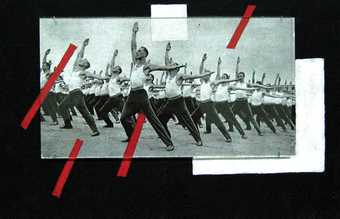
Fig.9
Detail from Exploitation of the Dead 1984–90
© Mladen Stilinović
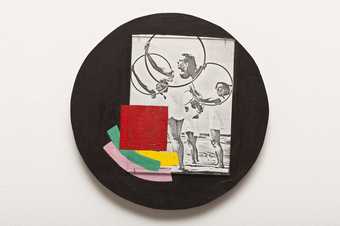
Fig.10
Detail from Exploitation of the Dead 1984–90
© Mladen Stilinović
Courtesy Branka Stipančić
The objects that make up Exploitation of the Dead, on the other hand, insistently emphasise the subject-object interaction as one characterised by pain and uselessness. The most important forms of pain here are those of hunger and of work. The cycle contains a number of found photographs in which we see human bodies subjected to patterns of labour and movement connected to socialist ideology. I say ‘subjected’ both because of the role of these activities in subject-formation, and because the art objects themselves, through the layering of the photographs with paint and other objects, foreground structures of superimposition. Those structures evoke a sense of the bodies performing something that comes from outside of them, by which they are semantically and physically weighed down, in a sense that parallels how the constructivist aesthetic is artificially imposed on the painted spoon. One example is a black-painted panel that bears a photograph of men of various ages and physiques wearing identical black pants and white sleeveless shirts (fig.9). They are engaged in group physical activity of the kind commonly on display at Yugoslavia’s Youth Day festivities, timed to coincide with Tito’s birthday and with the conclusion of a country-wide relay race (the Štafeta), which culminated in the delivery to the leader of an artisanal baton, typically symbolic of Yugoslav industry, culture or agriculture. The photograph overlaps a white square painted on the panel. Red, Malevich-like rectangular lines made of paper, as well as another painted white square, are superimposed over it. In this object, the physical exertion in the photograph comes across as futile, or characterised by a silliness that undermines its ideological function, while the materiality of the thing itself emphasises the constructed nature of the whole. In another panel, a group of attractive, white-clad young women perform exercises holding hoops, the round shapes of which are echoed by the round panel on which the image is mounted (fig.10). The pretty girls give this panel a playful and fanciful tone, heightened by the multi-coloured shapes superimposed over the photo in red, yellow, green, and pink.
Whereas the exercise images are somewhat humorous, the harsh side of collective exertion is driven home by another object, a white-painted rectangular panel with a photograph in the upper half, and a real, white-feathered goose wing affixed to it (fig.4).42 For Stilinović, white is the colour of pain.43 The wing swoops diagonally up from the lower-right hand corner, its tip gently overlapping the image. The sepia-toned photograph shows a gang of male and female labourers, their backs bent, engaged in digging and hauling earth. This is an image of a ‘work action’ (radna akcija), an organised event in which volunteers, primarily youth, worked on infrastructural and industrial projects. Such actions played an important role in rebuilding Yugoslavia following the Second World War and saw a revival in the 1970s, which was largely political and ideological in character. In Stilinović’s object, the severed bird wing, on which we can still see dried blood from where it was detached from the bird’s body, converges with the photograph to depict the radna akcija as brutal in character. The symbolism of a bird’s wing resonates with ambition, with the spiritual, and with the attempt to transcend the here-and-now for something greater. However, the inescapable, sad physicality of this particular wing instead drives home the inability of the labouring bodies smoothly to give flight to the dream of a socialist state. The wing that cannot fly away depicts the project of embodying ideology that collective labour represents as one that will ultimately exhaust and break the body. The subject-object distinction is collapsed here, but not in the optimistic way in which Arvatov collapses it. The gap between the ideal and the real persists, holding both the object and the subject captive. If Arvatov’s socialist things are cheerful ‘co-workers’ who go whistling to work, Stilinović’s objects might be read as lazy, disillusioned co-workers. They refuse the expenditure of energy necessary to make the system function and stress its burdensome quality.
A critique of work has been a guiding thread throughout Stilinović’s career. For example, the 1981 work Work is a Disease (Rad je bolest) consists of the title phrase written in red acrylic on a black board, with the additional inscription ‘K. Marx’ in the lower left-hand corner. (It is worth noting here that unlike in English, the Croatian word for disease or illness, bolest, encompasses the word for pain, bol). The false attribution of the quotation to Karl Marx proposes a twisting of Marxist ideology, wherein it is not just the social reorganisation of labour but rather its outright rejection that might form the site of collective resistance. The idea of refusing work as resistance resonates with a number of different strands in twentieth-century politics and thought, most notably with the Autonomia Operaia’s call to withdraw from work in the 1970s in Italy, not far from Stilinović’s home in Zagreb.
There were specific circumstances in Stilinović’s life which afforded him the privilege of avoiding work. Marijan Stilinović, the artist’s father, was a nationally famous Partisan resistance fighter, who had been a communist before the war and served a nine-year prison sentence for his involvement with the group Red Justice (Crvena pravda). Marijan Stilinović married fellow resistance member Nada Popović and, when Mladen was born, was editor of Belgrade newspaper Borba (Struggle). Marijan subsequently served as a diplomat for the Socialist Federal Republic of Yugoslavia, a position which took the family from Belgrade to Prague and Buenos Aires before returning to Zagreb, where in 1954 he helped found the City Gallery of Contemporary Art (Gradska galerija suvremene umjetnosti, the forerunner to today’s Museum of Contemporary Art).44 Shortly afterwards in 1956 he fell into disfavour for supporting Milovan Djilas’s argument for multi-party democracy, and moved his family to the politically marginal coastal town of Zadar, dying just three years later at age 55.45 Mladen, along with his siblings Sven and Vesna, as adults had access to their mother’s state pension, which afforded Mladen basic subsistence without a day job. Later, curator and art historian Branka Stipančić, Stilinović’s wife, helped support the couple through her earnings, and it was only late in life that Stilinović made a comfortable income through the sale of his artworks. The artist’s well-known text ‘In Praise of Laziness’ (1993) addresses this situation in a ventriloquistic manner, through a quotation from Marcel Duchamp when asked about what brought him pleasure: ‘First, having been lucky. Because basically I’ve never worked for a living. I consider working for a living slightly imbecilic from an economic point of view. I hope that someday we’ll be able to live without being obliged to work. Thanks to my luck, I was able to manage without getting wet.’46
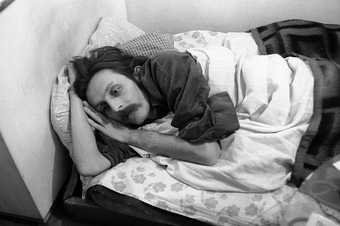
Fig.11
Mladen Stilinović
Artist at Work 1978
One in series of eight silver gelatin prints
© Mladen Stilinović
Courtesy Branka Stipančić
Stilinović understood laziness not only as a form of political resistance, but moreover as key to art’s autonomy. In the 1978 series of black-and-white photographs Artist at Work (Umjetnik radi) (fig.11), he appears in bed, in various states of apparent sleep and wakefulness. In some images, he looks like he’s dozing, while in others, he lies with his eyes open, staring at the ceiling or out in front of him. Artistic work is conflated here with sleeping, or perhaps more precisely, with refusing or failing to get out of bed. However, in contrast to associations between collective resistance and refusal to work, Stilinović’s refusal in Artist at Work is notably individualist. He lies alone, seemingly unresponsive, and the image is also devoid of any potential sexiness – and its implication of relationality – that we might associate with a bed. Refusal to work here is individualised art resistance, not organised collective resistance (though in dedicating the work to Neša Paripović, another artist associated with the New Artistic Practice, Stilinović implicitly positions himself as one member of a wider network of such individual creative resisters). The work can also be read as a self-ironising commentary on his own real ability to forego work. The artist’s text ‘In Praise of Laziness’ describes laziness as:
the absence of movement and thought, dumb time – total amnesia. It is also indifference, staring at nothing, non-activity, impotence. It is sheer stupidity, a time of pain, futile concentration. Those virtues of laziness are important factors in art. Knowing about laziness is not enough, it must be practiced and perfected.47
Key here is the idea that laziness is resistant to abstraction. It cannot undergo a division of ideology and materiality, but rather is nothing more than its material and corporeal embodiment through time-based practice, offering no conceptual nut that might remain once the specifics of its embodiment are stripped away. The quotation also highlights the semantic chain between laziness, sleep, and death already present in the images of Artist at Work. To sleep is a common euphemism for death, and in those images where Stilinović has his eyes open, staring blankly ahead, he might almost be mistaken for a corpse. This chilling effect is reinforced by the artist’s natural physique, which was always extremely thin, and by the dark circles under his eyes. French philosopher Michel Foucault argued that death is the limit of modern biopolitical power, and must be ignored by power, which can control a population’s mortality, but not control death.48 In this sense, death is a limit to work, not only in terms of actual physical labour, but broadly in terms of the productivity of the body orchestrated by biopolitics. However, although death might therefore constitute a kind of resistance, it does not offer a viable subject position from which to mobilise that resistance. In Exploitation of the Dead, death is a limit to the body’s forced productivity, but the artwork also emphasises, through its title, through its images of dead Malevich, and through Stilinović’s own appropriation of the dead Malevich’s style, how death eliminates the possibility for resistance. It renders the dead a resource able to be exploited by the living for their various rewritings of history and projects of self-promotion.
The problematisation of the body’s productivity elaborated through this interest in death plays out at another level in Exploitation of the Dead’s concern with food. The cutlery and dishes which dominate the cycle are connected intimately to food, the basic building material of our bodies. Food is conceptually and materially central to Stilinović’s practice, which sets it up in a series of circuits of negation with objecthood and value. We can see this in the painted spoons and plates with their ‘= 0’, which in addition to referencing Malevich could be read as evoking a lack of food – there’s nothing on the plate, only an ‘equals zero’ – but also the negation of the object itself.
Food is also present in Exploitation of the Dead through the inclusion of real cakes, which constitute the work’s most affectively potent address to the body. These desserts, in the single-serving sizes sold in patisseries all over central and eastern Europe, appear perched on small wooden shelves. The simple wooden shelves, which are attached to the wall via a metal hook, were produced by Stilinović prior to each show, and painted in monochrome white, red, or black. The desserts are placed the day of the installation (formerly by the artist, or by curators or collaborators), and left to become visibly decrepit over the course of a show.49 In the installation of the work at Documenta 12 in 2007, a piece of something that might have been banana cake, with creamy, yellow-white frosting, sat on a somewhat roughly hewn white shelf, on which the texture of the wood was clearly visible through the pigment. A thin layer of parchment paper barely separated the cake from the shelf, emphasising their cohesion as a unit of display. This is an art object, not a food-object, or rather a food-become-art-object, offered for observation and not for consumption. The individual portion of the cake, and the small, delicate size of the cake/shelf, proffer it intimately to me as the viewer, appealing to me visually in a way that is inseparable from the thought of eating the cake. But the piece of cake has no use value; it will not enter into an integrated relationship with my body. The cakes, intended as a reference to Marie Antoinette, evoke the maxim ‘Let them eat cake’, which offers cake as a luxury substitute for the lack of bread, an item that fulfils basic need.50
Stilinović’s use of cake relates to his wider use of ephemeral food materials, which have included bread (for example, Foot-Bread Relationship 1977), packaged biscuits, and eggs (for example, Untitled (Egg and Money in Bowl) 1997). His use of food resonates with the practices of other artists such as Daniel Spoerri, Marcel Broodthaers and Raša Todosijević, who have worked with the ephemerality of food and its address to the body within a conceptual interrogation of the status of art. In a mode analogous to some of Broodthaers’s works with eggshells, such as Painting with Eggs and Stool 1966, Stilinović’s cakes in Exploitation of the Dead reinforce the feeling that the objects build an environment which encompasses the viewer, because we become hyper-aware of the environmental conditions in the exhibition space that will lead to either the desiccation or rotting of the cakes. Todosijević’s Nailed Bread 1971/2010, created a few years prior to Stilinović’s Foot-Bread Relationship, presents an oval-shaped loaf affixed to a board with three giant vertical nails in a way that evokes the crucifixion of a human body. Todosijević’s 1975 ‘Edinburgh Statement’, which enumerates the many people – from artists, to gallerists, to janitors, to philosophers – who make a profit on art, show him engaging with ideas of exploitation similar to those that preoccupied Stilinović. In both artists’ work, the use of food grounds these questions of power in an intimate address to the body, which also encompasses an institutionally critical attention to the physical and ideological conditions of art’s display.
In addition to the desserts, a number of other objects in Exploitation of the Dead enact a collision between the categories of food, objecthood, and money, such that these categories come to problematise the security of value as such. For instance, a silver fork is stuck through a stack of four crumpled, yellowed Yugoslav bills. The fork that pierces the notes has a heavy handle, and is embellished by old-fashioned, decorative ridges between the handle and the tongs. On top is a 500-dinar note, which would have been virtually worthless in the late 1980s when Stilinović made Exploitation of the Dead. The object is also a clear visual pun on the fact that you cannot eat paper. Not only has the money lost its value, but the fork is rendered useless too, an eating utensil that cannot be used when there is nothing to eat. Its utility thwarted, the fork becomes a symbol of the cruelty of privation.
The fork puncturing the bills wryly highlights the return of the money to its material basis: the unstable Yugoslav economy had rendered the money just paper, with no exchange value and little possible use value except creative recycling in an artwork. In Stilinović’s work as a whole, money appears as a symbol of universal translatability. He has repeatedly made statements such as ‘money is the only language everybody understands’.51 However, his fascination with money’s semantic transparency always occurs in relation to the process by which that universality is thwarted through money’s necessary materialisation, its status as ‘only paper’.52 The fork and stack of bills exaggerates the vulnerability to which currency is opened up through the process by which its universal signifier is materialised in a certain time and place, in a piece of paper or metal marked by a specific number. As such, the devalued banknote, with its statement of claim on a certain value it was unable to retain, becomes the index of historical processes that defy both individual and collective control. This is the place where Stilinović locates experience: caught between large-scale historical shifts and the daily grind, with the body as its crux. Exploitation of the Dead represents this position of inertia as one that stymies the possibility of universal translation, directing us back towards particular, material sites of experience and the specific power relationships that inhere within them. In the next and final section, I will further analyse this question of translation relative to Stilinović’s address of the different positions occupied by his diverse viewers.
Viewership and translation
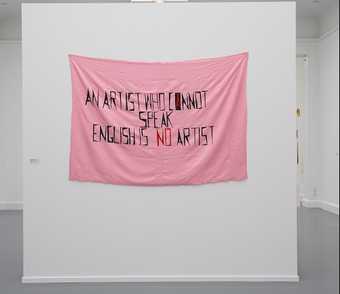
Fig.12
Mladen Stilinović
An Artist Who Cannot Speak English is No Artist 1992
Acrylic on artificial silk
© Mladen Stilinović
Courtesy Branka Stipančić
Let us return to the scene with which we opened, of Exploitation of the Dead’s exhibition at Documenta, twenty years after its creation. If the work revolves around an uneasy triangulation of the object with different and unequal types of labour (material versus immaterial, exploitative versus privileged), how does it treat the inequalities of position between viewers themselves, and specifically, the inequality of their access to discourses of power? That question is bound up in Stilinović’s work as a whole, with the problem of translation, and with the different ways in which translation can misfire. In 1992 he created An Artist Who Cannot Speak English is No Artist (fig.12), which consists of the title phrase written in spindly black caps with red accents on a pink cloth background. This work can appear like a rather straightforward critique but is in fact quite complex. An Artist Who Cannot Speak English is No Artist focuses on the intersection between translation and power, critiquing what visual culture theorist Ana Peraica calls the ‘history market’, which makes exotic eastern European artists such as Stilinović in demand, but also requires that they and their work ‘speak English’.53 Writing on art practices that engage with documentary strategies, art historian T.J. Demos has argued that contextually dependent opacity, the rendering of a work illegible outside of a particular local or national context, constitutes an important tactic of resistance to the ‘history market’ on the part of global contemporary artists.54 An Artist Who Cannot Speak English is No Artist speaks to both non-native and native speakers of English in different, specific ways. Whatever the viewer’s personal relationship to English and to its status as a global lingua franca, the work asks them to reflect on that, and moreover to see themselves as part of a relational world of people differently positioned, with different degrees of linguistic power and privilege. It is notable, however, that the work itself diagnoses that unequal field without refusing to participate in it.55 An Artist Who Cannot Speak English speaks English, both in the sense that the text is in English, and in that the work positions itself as operating according to a logic of translation which reflects its own real movement across global exhibition contexts.
Obviously, when Exploitation of the Dead is shown in contexts such as Documenta, it will encounter diverse audiences, some of whom have historically and culturally specific knowledge of Yugoslavia, and many of whom do not. In this respect, certain aspects of the work that are specific to Yugoslavia’s history will fail to ‘translate’ for many viewers, in a way which is bound up with but also distinct from the question of linguistic translation. I saw Exploitation of the Dead at Documenta for the first time, before I had any context for understanding Croatian and ex-Yugoslav art of the 1980s. A couple of years later, while I was on a research trip to Zagreb, a curator based there commented to me that when foreigners got interested in Croatian art, it was always through the work of Mladen Stilinović. This observation stuck with me and became a reflection point on my own attraction to his art. It also made me reflect more broadly on the dynamics of legibility and translatability that function in his work as a whole.
Stilinović uses language, including the English language, in a way that is often simple to the point of being child-like.56 This simplicity tends to enable an immediate, intuitive reading of a given work by a broad audience, at the same time as it is based on an acute understanding of how ideology can instrumentalise language. Relative to the circulation of Stilinović’s art in the deracinated terrain of global contemporary art venues such as e-flux, Manifesta, Documenta, and the Carnegie International, his use of language both enables a dimension of easy legibility for his works and implies a critique of the hegemony of the English language. At the same time, he has been known strategically to refuse translation. A key early instance of this was in a speech of protest against English that he delivered at the symposium titled Works and Words held at De Appel in Amsterdam in 1979, which aimed at ‘creating confrontation between artists who share a common sensibility from Hungary, Czechoslovakia, Poland, Yugoslavia and the Netherlands’.57 Stilinović delivered his speech of protest against the English language in Croatian, and made the videographer who filmed it sign a document promising it would never be translated.58 He employed a similar tactic again in 2011 during a talk at the Salzburg Summer Academy of Fine Arts.59 Stilinović opened by mentioning the Amsterdam speech. ‘But the lecture was in Croatian’, he commented, ‘so nobody understood what I was talking about.’ He then recited:
Svaka ptica lepo poje Ali kos! Ali kos! I domačin lepo jebe Ali gost! Ali gost!
‘Like that’, he concluded, looking around at the audience, ‘so nobody understood’. In the lecture, Stilinović delivered this fragment in a flat, affect-less way, as if making the most banal demonstration of what Croatian speech sounds like. However, the content of what he uttered is in fact provocative. It can be translated as:
Every bird is good at singing Oh, but the blackbird is the best! And the host, too, is good at fucking Oh, but still better is the guest!
This fragment is a quotation from a folk song from the former Yugoslav territories, one of a collection assembled by Vuk Karadžić, a Serbian linguist who reformed the Serbian language and standardised the Serbian Cyrillic alphabet in the nineteenth century. Stilinović’s English-language framing presents the song’s content as insignificant, and perhaps he indeed selected it without giving it much thought, as the point he was trying to make was about the hegemony of the English language.60 At the same time, the choice of the song is intriguing because its roots in regional folk culture and its connection to Karadžić’s project of nationalist modernisation of language evoke the distinct strands of language and culture that exist in the former Yugoslav territories; the complex relationships that exist among them (including attempts, today, to stress linguistic differences between the mutually intelligible Bosnian, Croatian, and Serbian); and the different processes of uneven modernisation the region has undergone. Moreover, the song introduces themes of sexuality, hierarchy, hospitality and power that can be read to resonate in multiple, provocative ways with the question of how different linguistic and ethnic groups in this region relate. These themes relate in turn with Stilinović’s own biography, as a Croat born in Belgrade, the child of a Yugoslav national hero and diplomat. The song is also lewd, evoking a promiscuous body as the place where these questions of power and hospitality play out.
Stilinović’s act of reciting this song presented his Salzburg audience, whose common language is English, with a limit to their ability to translate and to understand across cultural differences. It also may have created varied experiences among the audience, as some might have understood his words, while others could not. In his practice more broadly, translation is a process that cannot occur smoothly but always comes with friction. I propose that an appropriation of the concept of ‘abusive translation’ articulated by film scholar Abé Markus Nornes can be helpful in understanding the value of presenting audiences with language or with cultural references that they may not understand or might only imperfectly be able to translate. Nornes, in his discussion of film subtitles, defines the abusive translation in opposition to what he calls the ‘corrupt translation’, which conceals its own investment in domesticating the source text. By contrast, the abusive translation takes bold creative and experimental license in order to ‘avoid this kind of erasure of difference, seeking to intensify the interaction between the reader and the foreign’. Ultimately, its goal is ‘a willingness to confront otherness without dominance or erasure’.61 It is notable that Nornes highlights how such a willingness not to erase difference essentially proceeds via a mistranslation, which will obscure parts of the text and distort others by amplification.
Exploitation of the Dead revolves around Malevich, that is, around Stilinović's engagement with an artist foreign to his own context, both nationally and in terms of historical period. The work is an interpretation of Malevich’s avant-garde history that does not pretend to place him in a correct historical context, but rather mixes his image and memory with historical and visual fragments germane to Stilinović's Yugoslavia at the other end of the twentieth century. With the work’s title in mind, it is tempting to read Stilinović as an abusive translator who ‘exploits’ Malevich in order to stage an encounter with the radical nature of his art and ideas. Viewers of Exploitation of the Dead might also in turn perform their own abusive translations. The work presents objects and images that can be read in ways specifically referential to Yugoslavia’s twentieth-century political history and to its avant-garde lineage, but that also invite mistranslation by viewers unfamiliar with the country’s history. For these foreign viewers, the highly recognisable references to the Russian avant-garde can collapse the work around the axis of a generalised conception of communism. In 1991 Stilinović commented in a Croatian newspaper interview that elements of Exploitation of the Dead, such as the use of red, which within his context was clearly subversive, were read by foreigners as a direct assertion of a communist position.62 To see that misreading as a simple accident of the work’s travel from its local context through the global art world underestimates Stilinović’s interest in the structural nature of communication and how it can misfire. Arguably, this misfiring has a hopeful dimension, because infelicitous translation is unpredictable and thus opposed to instrumentalisation. Stilinović was an adamant critic of the instrumentalisation of language by ideology, and his interest in how communication can fail forms a point of continuity between the work he created and circulated primarily in Zagreb for a very small audience in the 1970s, up through to the pieces made from the late 1990s on, for which the initial audience was more immediately global.
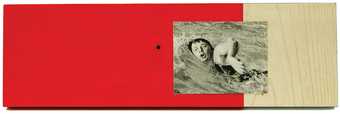
Fig.13
Detail from Exploitation of the Dead 1984–90
© Mladen Stilinović
Exploitation of the Dead reaches from a crumbling Yugoslavia of the 1980s to both a (then) present and a future audience. Encountering the work now, we are stuck in the middle, as it were, unable to rid ourselves from a painful and strange collective history of failed utopianisms. The affective qualities of the objects create a feeling of stickiness, in which the residue of past political and aesthetic projects adheres to us bodily, breaking down the illusion that we could step forward, clean, into a new and brighter future. In one object in the series, a photograph of a swimmer is stuck over an elongated red and bare wooden panel, a single black nail hammered into the wood just left of the image (fig.13). The swimmer seems to be working hard, her mouth open to breathe and her arm raised for another stroke into the water. The image is cropped in very close on her in a way that prevents us from seeing where she is going, conveying a sense of being heavily belaboured, while at the same time grasping for direction, for narrative. Exploitation of the Dead places us in this position, searching, laboriously, for a radical historical narrative that would point us clearly in some positive future direction. Stilinović persistently redirects that search towards a moral ambivalence that encompasses himself, his viewers, and his historical subjects. But the work does in fact open up the possibility of an ethical position, in the sense that its rejection of utopianism is also a stance in and for the relationality of the present world. Exploitation of the Dead presents the object in an avant-garde lineage as the medium through which historically failed attempts at progress continue uncomfortably to stick, to seep into the fabric of everyday life. But the object is also as a vehicle through which embodied viewers and the labouring bodies the cycle represents can meet each other in a process of continually shifting encounter. That process of encounter does not eliminate exploitation, but stresses its immanence to a dynamic relational field where ongoing change is not just possible, but inevitable.
